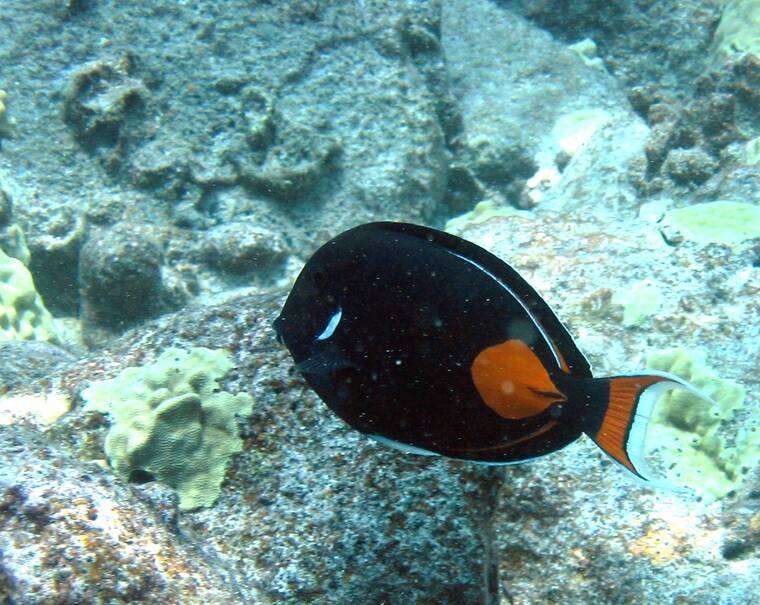BLNR looks to protect paku‘iku‘i in West Hawaii waters
The Board of Land and Natural Resources is mulling a rule that would prohibit the taking of a certain fish anywhere in West Hawaii waters for at least two years.
Paku‘iku‘i, also called the Achilles tang, is valued not only as a vibrant aquarium fish but also as a food source, which has led to a significant decline in the fish’s population in West Hawaii.
Paku‘iku‘i, which is listed as a species of least concern by the International Union for the Conservation of Nature, are protected only within the Miloli‘i Community-Based Subsistence Fishing Area, an 18-mile expanse of ocean surrounding the West Hawaii village of Miloli‘i.
Within the Fishing Area, paku‘iku‘i are protected until 2027, save for a “paku‘iku‘i rest area” within the area, where harvesting the fish is prohibited indefinitely.
That protection was enacted after the Miloli‘i community noticed an ongoing decline in the local paku‘iku‘i population and incorporated the moratorium on taking the fish into the Fishing Area’s founding rules.
However, a similar decline has been observed elsewhere in West Hawaii waters, which has incited the Department of Land and Natural Resources to propose an expansion of the moratorium across the entire coast.
“As somebody who’s lived over here for years, who goes diving quite regularly, it’s just not the same,” said West Hawaii resident Mike Nakachi.
Data from the DLNR’s Division of Aquatic Resources indicate paku‘iku‘i population declines of up to 95% between 1999 and 2021 in certain locations. The number of the fish harvested for commercial aquariums has declined by about 25% from its peak in 1990, while the value of the fish has more than doubled in the last decade — an aquarium paku‘iku‘i sold for about $7 in 2000, but in 2018 the same fish would sell for more than $20.
The data also suggests that those paku‘iku‘i that remain in West Hawaii waters are, on average, “substantially smaller than they were previously,” according to the proposed rules. The average length of a paku‘iku‘i in 2008 was about 18 centimeters, while the average length in 2018 was a little over 14 centimeters.
While environmental advocates support the DLNR’s proposal to enact the two year moratorium on paku‘iku‘i harvesting, they also viewed the plan as DLNR trying to clean up a mess it caused.
“The main issue is that it was the DLNR who let the aquarium trade take huge numbers of paku‘iku‘i while they were doing these studies,” said Rene Umberger, executive director of marine life advocacy group For the Fishes. “The aquariums were taking up to 80% of the entire population, including the babies, before they were able to reproduce.”
Nakachi said aquarium harvesting was effectively unregulated, adding that any limits imposed were in name only.
“Nobody was regulating it — there was nothing stopping someone from taking 15 or 1,500 fish,” Nakachi said.
Aquarium harvesting in West Hawaii was banned following a 2017 lawsuit, but the damage has already been done, with no guarantee that it can ever be repaired, Umberger said.
While other reef fish targeted by aquariums have rebounded somewhat since the ban on aquarium fishing, paku‘iku‘i have not seen the same recovery, because they are also harvested for food.
“Basically, you have the people eating the fish, and they’re taking the larger fish,” Nakachi said. “And then you have the aquariums targeting the young ones. And you can see what that will start to do to the population.”
Umberger said the total moratorium on paku‘iku‘i harvesting will help the fish, but also will unnecessarily hurt local subsistence fishermen.
“Basic fishery management is that you don’t take fish before they’ve had a chance to reproduce,” Umberger said. “But the aquariums, they specifically targeted the babies, and now the subsistence fishers are going to suffer.”
The draft rules propose an escalating series of fines as penalties for those who violate the two-year prohibition, ranging from $1,000 for a first violation to $3,000 for a third or subsequent violation within five years of the previous one.
Under a 2021 law aimed at streamlining the DLNR’s administrative rulemaking process in situations involving “rapidly changing resource conditions,” the DLNR aims to have the draft rules take effect upon approval by the BLNR without the need for public hearings.
DLNR spokespeople declined to comment on the pending BLNR action.
The BLNR will make a decision regarding the rule today. People can view the meeting online at youtube.com/boardoflandandnaturalresourcesdlnr.
Email Michael Brestovansky at mbrestovansky@hawaiitribune-herald.com.


